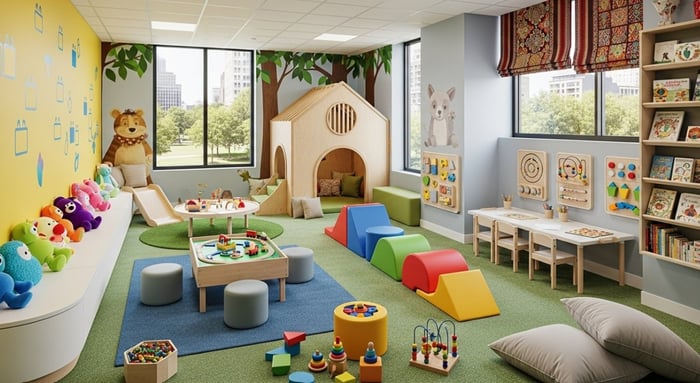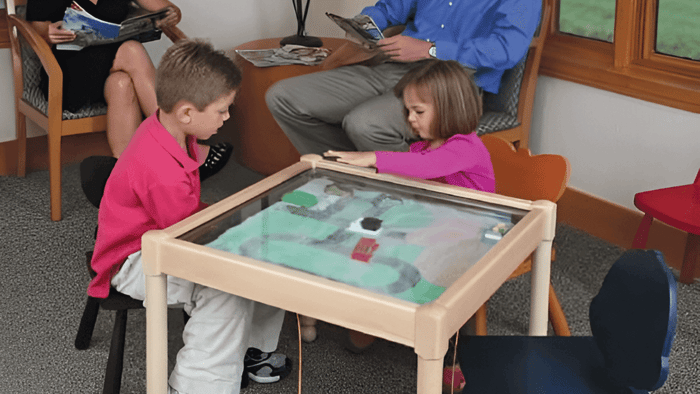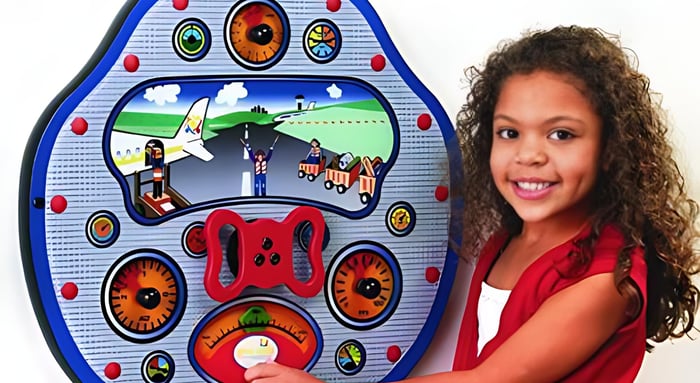
Auto Service Center Waiting Rooms: Childproofing Checklist
Table of Contents
- Every year, thousands of children are injured in waiting rooms due to hidden dangers like tip-over furniture and entrapment zones. But auto service centers are discovering that proper childproofing isn't just about safety—it's becoming their secret weapon for attracting loyal family customers.
- Key Takeaways
- Why Waiting Rooms Are Magnets for Childhood Accidents
- Critical Physical Hazards to Eliminate
- Secure Furniture and Access Points
- Safe Entertainment Solutions
- Maintenance and Inspection Protocols
- Transform Your Waiting Room Into a Family-Safe Business Advantage
- FAQs
Every year, thousands of children are injured in waiting rooms due to hidden dangers like tip-over furniture and entrapment zones. But auto service centers are discovering that proper childproofing isn't just about safety—it's becoming their secret weapon for attracting loyal family customers.
Key Takeaways
- Auto service center waiting rooms can contain hidden dangers that may lead to serious childhood accidents, such as choking hazards and entrapment zones
- Safety measures include eliminating entrapment openings measuring between 3½ and 9 inches wide, securing all furniture to prevent tip-overs, and covering electrical outlets with tamper-resistant plates
- Commercial-grade, easy-to-sanitize entertainment options like wall-mounted activity panels and magnetic tiles create safer play environments than traditional toys
- Weekly safety walkthroughs from a child's perspective combined with daily cleaning protocols prevent both accidents and disease transmission
- A properly childproofed waiting room transforms potential liability into a competitive business advantage that attracts and retains family customers
Auto service centers face a unique challenge: creating safe environments for children while parents focus on vehicle repairs. The combination of industrial surroundings, distracted adults, and curious young minds creates a perfect storm for accidents. However, with proper childproofing measures, service centers can transform their waiting areas into family-friendly spaces that build customer loyalty while protecting their most vulnerable visitors.
Why Waiting Rooms Are Magnets for Childhood Accidents
Waiting rooms present a deceptive danger zone where children's natural curiosity collides with adult distraction. When parents become engrossed in paperwork, phone calls, or conversations with service advisors, children instinctively begin examining their new environment. This examination behavior, while developmentally normal, can quickly turn dangerous in spaces not designed with young visitors in mind.
The automotive service environment compounds these risks significantly. Unlike pediatric offices or family-friendly restaurants, auto shops weren't originally designed with children in mind. They contain industrial elements, sharp objects, and mechanical hazards that create what safety experts call "attractive nuisances" - features that naturally draw children's attention but pose serious injury risks.
From 2020 through 2022, an estimated 17,800 people were treated each year in hospital emergency departments for tip-over injuries. Professional-grade waiting room solutions address these concerns by creating designated safe zones where children can play without encountering dangerous elements.
Critical Physical Hazards to Eliminate
1. Choking Hazards from Small Objects
Small objects pose immediate choking dangers for children under five years old. Auto service environments naturally accumulate items like paperclips, tacks, coins, magnets, and button batteries - all potentially fatal if swallowed. Service centers must conduct thorough sweeps to remove these hazards from all accessible areas.
The most dangerous culprits include button batteries, which can cause severe internal burns in as little as one to two hours of ingestion, and small magnets that can cause intestinal blockages when multiple pieces are swallowed. Implement a strict "nothing smaller than a toilet paper tube" rule for all items within children's reach.
2. Electrical Outlet Dangers
Standard electrical outlets present serious electrocution risks when curious toddlers insert objects or fingers. The Electrical Safety Foundation International (ESFI) highlights the importance of Tamper Resistant Receptacles (TRRs) in preventing electrical outlet injuries among children. Plastic outlet caps, often used as an alternative, pose choking hazards and are easily removable by toddlers. Install tamper-resistant electrical outlets or full-coverage outlet plates that prevent access entirely.
Pay special attention to power strips and extension cords, which multiply electrical hazards. Route all cords behind furniture or use cord management systems to keep them completely out of reach. Consider battery-powered alternatives for frequently moved equipment to reduce cord exposure.
3. Entrapment Zones Between 3½-9 Inches Wide That Risk Strangulation
Gaps measuring 3½ to 9 inches wide create deadly entrapment hazards where children's bodies can pass through but their heads become trapped. This specific measurement range appears in spaces between stair balusters, furniture legs, and decorative elements throughout many waiting areas.
Conduct detailed measurements of all openings in your waiting room, paying particular attention to areas beneath seating, around divider walls, and near architectural features. Any opening within this dangerous range requires immediate modification using filler panels, protective barriers, or furniture repositioning.
4. Sharp Edges and Protruding Hardware
Sharp corners and protruding hardware at child height can cause severe lacerations during normal play activities. Children often move quickly and unpredictably, making collision injuries particularly common around coffee tables, counters, and seating with hard edges.
Install corner guards on all sharp furniture edges and cushion any protruding hardware with appropriate padding. Don't overlook the undersides of tables and chairs where children frequently crawl - these areas often contain the sharpest and most dangerous protrusions.
Robot Factory Activity Wall Toy
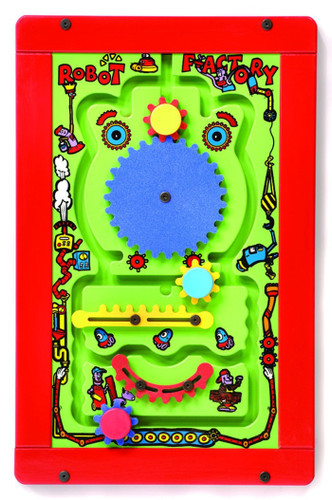
$816.27
Our Robot Factory Activity Wall Toy can mount to wall or free standing elements. Moving and fixed big, small, spindle and line gears create a cause...… read more
Secure Furniture and Access Points
Anchor Heavy Items to Prevent Tip-Overs
Tip-overs of chests, bureaus and dressers sent an estimated 1,800 children to hospital emergency rooms each year from 2020 through 2022, according to a newly released report by the Consumer Product Safety Commission (CPSC). Children naturally climb on furniture, and even relatively light items can become deadly when they fall on small bodies.
Secure all furniture taller than 30 inches to wall studs using furniture straps or L-brackets rated for the item's weight. This includes bookshelves, display cases, coffee stations, and any freestanding storage units. Remember that anchoring to drywall alone provides insufficient protection - always locate and attach to structural wall elements.
Hardware vs Pressure-Mounted Safety Gates for Repair Bay Access
Controlling access to dangerous areas requires choosing the right gate system for each situation. Hardware-mounted gates provide superior security for high-risk areas like repair bays, parts storage, and employee work zones. These gates attach directly to wall studs and can withstand significant force from determined climbers. Always use a hardware mounted gate at the top of stairs – these gates are the most secure.
Pressure-mounted gates work adequately for low-risk area separation but should never be used at the top of stairs or to block access to truly dangerous zones. Install hardware-mounted gates at all entrances to repair areas, ensuring they're tall enough (minimum 36 inches) to prevent climbing and include self-closing mechanisms.
Safe Entertainment Solutions
Durable Commercial-Grade Options
Auto service center waiting rooms require entertainment options that withstand heavy use while maintaining safety standards. Wall-mounted activity panels eliminate loose parts while providing engaging play experiences that don't create mess or safety hazards. These panels typically feature bead mazes, gears, and sensory elements designed for repeated cleaning and sanitization.
Activity cubes constructed from sealed wood or reinforced plastic offer durability and easy maintenance. Choose options with smooth surfaces, secure construction, and no removable parts that could become choking hazards or get lost. Magnetic building tiles provide quiet, engaging play while remaining easy to sanitize and organize.
Safe Toy Options For Auto Service Waiting Areas
| Toy Type | Recommended Features | Safety Benefits |
|---|---|---|
| Wall-Mounted Activity Panel | Fixed to wall, no loose parts, wipeable surfaces | No tripping hazard, prevents choking, easy sanitation |
| Bead Maze/Tabletop Cube | Sturdy, one-piece design, commercial-grade materials | No removable pieces, minimal mess, durable |
| Magnetic Tiles/Blocks | Large format, non-toxic plastic, easy-to-clean finish | Avoids small parts/choking, silent, safe for wide age range |
| Vinyl Soft Seating/Play Mats | Seamless vinyl, non-slip base, no gaps or sharp corners | Cushioned surface, easy to clean, minimizes injury risk |
| LCD Drawing Pads | Battery-powered, no ink or markers, simple surface | Mess-free, quiet, suitable for various ages |
| Board Books/Quiet Books | Thick pages, sewn-in features, no loose or paper parts | No choking hazard, easy to sanitize and store |
Easy-to-Sanitize Materials
High-traffic waiting rooms require entertainment options that survive frequent disinfection without deteriorating. Hard plastic, laminated surfaces, and sealed wood withstand repeated cleaning with commercial disinfectants while maintaining their appearance and structural integrity.
Avoid any entertainment options with fabric components, intricate mechanical parts, or porous materials that harbor bacteria. Silicone-based fidget toys, wipeable play mats, and dishwasher-safe manipulative toys meet hygiene requirements while providing appropriate sensory experiences for young children.
What to Avoid in Auto Service Settings
Plush toys, fabric dolls, and anything with small removable parts create ongoing hygiene and safety challenges in commercial environments. These items absorb fluids, harbor germs in hard-to-clean crevices, and often contain small parts that become choking hazards when children disassemble them during play.
Electronic toys with volume controls, battery compartments, or breakable screens introduce additional hazards and maintenance requirements. Stick to simple, robust toys specifically designed for commercial use that can withstand aggressive cleaning protocols and constant handling by multiple children.
Play Panel Wooden Activity Cube
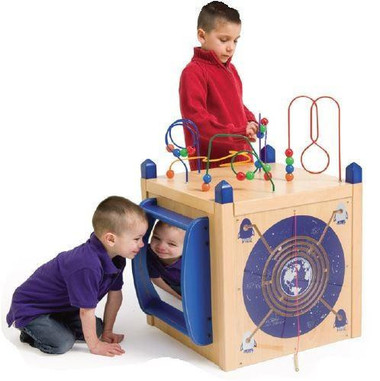
$1,613.22
Introducing the Gressco Play Panel Activity Cube - the ultimate activity center that will delight both children and parents alike. Designed with convenience in mind,...… read more
Maintenance and Inspection Protocols
Weekly Child's-Eye-Level Safety Walkthroughs
Regular safety inspections from a child's perspective reveal hazards that adult-height surveys miss entirely. Conduct weekly walkthroughs by literally getting down to child level - crawling under tables, examining floor-level hazards, and checking for newly created dangers from routine business operations.
Create a standardized checklist covering electrical outlets, furniture stability, choking hazards, sharp edges, and entrapment zones. Assign responsibility to specific staff members and maintain documentation of completed inspections. This systematic approach ensures consistent safety maintenance while creating legal protection for your business.
Daily Cleaning Schedule to Prevent Disease Transmission
Children touch everything and frequently put hands in their mouths, making aggressive cleaning protocols necessary for preventing disease transmission. Implement daily sanitization of all play surfaces, door handles, seating, and floor areas using EPA-approved disinfectants effective against common childhood illnesses.
Pay particular attention to toys and manipulative objects that children handle frequently. Establish rotation systems where toys are removed for thorough cleaning while backup sets remain available for continuous play. This approach maintains entertainment options while ensuring proper sanitization between uses.
Transform Your Waiting Room Into a Family-Safe Business Advantage
A properly childproofed waiting room becomes a powerful competitive advantage that attracts family customers while reducing liability risks. Parents actively seek service providers who accommodate their children's needs, and word-of-mouth recommendations from satisfied families drive significant business growth.
Investment in professional childproofing pays dividends through increased customer retention, positive online reviews, and reduced insurance liability. Families spend more money with businesses that make them feel welcome and safe, creating long-term customer relationships that extend across multiple vehicles and years of service needs.
The transformation from potential hazard zone to family-friendly environment requires careful planning and ongoing maintenance, but the business benefits far outweigh the initial investment costs. Service centers that prioritize child safety distinguish themselves from competitors while building reputations as community-focused, responsible businesses.
Quick Childproofing Checklist For Auto Service Center Waiting Rooms
Block access to service bays, parking lots, and employee areas using child gates or secure doors.
Cover all electrical outlets and secure or hide charger cables and cords.
Remove or anchor anything that can tip over, such as bookshelves and small tables.
Use only commercial-grade toys without tiny parts, and sanitize toys frequently.
Keep all cleaning chemicals, hand tools, and spare parts locked away and out of sight.
Place soft, non-slip mats in play areas to prevent trips and cushion falls.
Ensure all areas are clearly visible from seating; avoid visual barriers and blind spots.
Post emergency procedures and keep first aid supplies readily available but out of children’s reach.
For waiting room solutions designed specifically for automotive environments, Little People's Cove offers commercial-grade entertainment and safety products that help auto service centers create truly family-friendly spaces.
FAQs
What toys are durable and easy-to-sanitize for auto dealerships?
Play Cubes and Activity Cubes
Wall-Mounted Activity Panels
Magnetic Tiles and Blocks
Hard Plastic or Silicone Toys
Are there toys or play areas available for children while parents attend service appointments, and do these amenities help make the waiting experience more enjoyable?
Yes, many service centers offer toys or play areas for children, which help keep them engaged and entertained while parents handle service appointments. These amenities not only make the waiting experience more enjoyable for children by reducing boredom but also provide parents with peace of mind, allowing them to focus on the appointment without distraction. Overall, such features contribute to a more pleasant and family-friendly waiting environment.
Are the toys designed to be durable and safe, capable of withstanding frequent and rough use in busy service centers?
Yes, toys provided in busy service centers are typically chosen with durability and safety in mind, ensuring they can handle frequent and sometimes rough use by children. They are often made from sturdy, easy-to-clean materials and designed without small or hazardous parts, helping them remain both long-lasting and safe in a high-traffic environment.

